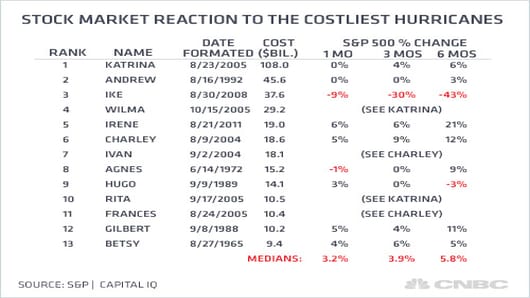By the time trading starts back up in New York, traders should have had time to assess how severe the damage could be from Hurricane Sandy and the stormy weather that hit the east coast this week.
The high tides from a full moon and the collision of Sandy with another storm made for a powerful surge that sent waves into lower Manhattan, close to the New York Stock Exchange, and other heavily populated areas around New York city and along the coastline early Monday evening. Power was shut down for blocks and in the Wall Street area, where subways were threatened by salt water rolling into lower Manhattan.
(Track the Storm Here From The Weather Channel)
Stock trading was to be closed for a second day Tuesday. Bond trading was conducted in a shortened session Monday, but is also closed Tuesday. Energy and other commodities will continue to trade electronically.
Sandy came ashore in southern New Jersey Monday evening, where abnormally high tides flooded the coastline, swamping Atlantic City and other Jersey shore beach communities. By the time it made landfall, the storm was stripped of its hurricane status.
"It's a challenge because all events are unique. Sandy is a little more unique than most. What we looked at with Sandy is an enormous area with large winds," said Tom Larsen, senior vice president of EQECAT, a catastrophe risk modeling firm used by insurance companies and others. EQECAT's forecast for economic losses from Hurricane Sandy is $10-20 billion, and insured damage would be about $5 to $10 billion. Insured damage does not include what would be covered by federal flood insurance.
(Read More: What to Expect When the Lights Go Out)
"This type of event is really difficult," said Larsen, even before New York began to flood. "…the subways are a big concern." Larsen said the storm is on par with Hurricane Irene, or a bit more severe. The economic impact estimate includes the cost of business interruption, and also the impact to public buildings, roads and bridges. Insurance companies with exposure include Chubb, Allstate, Hartford Financial and Travelers .
Corelogic estimates that 284,000 residential properties, valued at $88 billion, were at risk from the storms in mid-Atlantic states.
Morgan Stanley analysts estimate that the initial forecasts for Hurricane Sandy insured losses of $5 to 10 billion should not result in big profit hits or price increases for reinsurers. They said the loss level should be similar to Hurricane Irene, at about $7 billion. Irene hit the east coast in 2011. Hurricane Katrina's insured losses totaled an estimated $62 billion.
A number of companies postponed earnings announcements Monday, and others were expected to take similar steps Tuesday.
J.P. Morgan chief U.S. equity strategist Thomas Lee said ironically housing may be one sector ultimately stimulated by the after effects of the storm, as homeowners seek to make repairs or rebuild. He said another more immediate impact should be the positive impact on retailers from consumers rushing into stores this past weekend for storm supplies but also shopping for other items, like apparel. "Imagine millions of homeowners taking this action, in these major cities," he said. "That's definitely got to be helpful despite that we end up with two days where nobody can go to stores."
(Read More: Investing in Hurricanes? A Few Ideas)
Lee does not expect a huge impact on stocks when the market reopens but he said it might sell off initially. "It is kind of skittish," he said. "It's coming at a time when we were already worried about the fiscal cliff. It's not a great time for this to be coming."
Another impact from the storm could ultimately be a drop in fuel prices, as the storm-forced shutdowns kept drivers off the road. Initially gasoline futures were higher, but they were flattish in evening and afternoon trading Monday, as it seems the demand destruction may outweigh temporary supply disruptions from east coast refiners cutting back. Of the five major refineries, just Philips 66 refinery in Linden, N.J. was shutting down completely.
Andrew Lipow, president of Lipow Oil Associates estimates a possible loss of 1.5 to 1.7 million barrels of gasoline production from the storms, but demand should be down sharply. He estimates 2 to 2.5 million barrels in total gasoline demand will be lost from Washington to Boston and west to Ohio and northward into Maine.
Follow Patti Domm on Twitter: @pattidomm
Questions? Comments? Email us at marketinsider@cnbc.com




